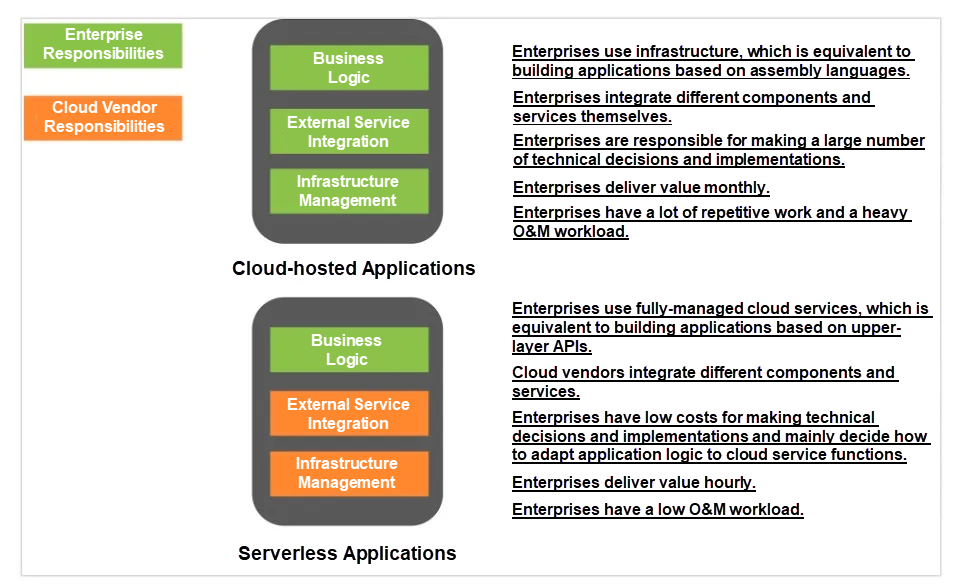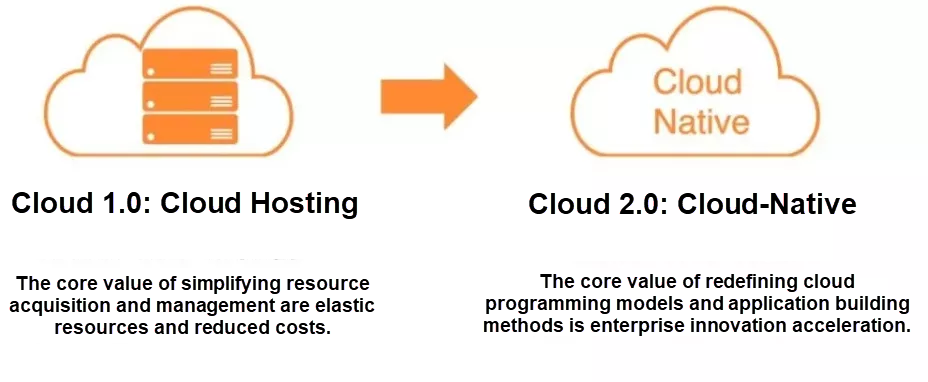By Buchen, a Senior Technical Expert at Alibaba Cloud

The IT industry makes important breakthroughs every few years. Looking back at the history of the computer, we will find that abstraction, decoupling, and integration are the commonalities of these breakthroughs. Each advance in abstraction, decoupling, and integration in the industry takes innovation to a new level and generates huge markets and new business models.
With serverless services, developers can focus their efforts on service logic development and integration. This significantly shortens the development period and reduces the O&M costs. "Serverless is changing the future software development model and process and is the future of cloud computing." Revolutions in the technology field are often driven by the emergence of new technologies. However, creating value for customers is the ultimate goal of any technical revolution. This article explains why serverless is the future of cloud computing in terms of its value to enterprises and cloud vendors.
Since creating value for customers is the ultimate goal of any technical revolution, we need to understand customers' pain points, the advantages of serverless in solving these pain points, and whether serverless can create new opportunities for customers. Here, we will look at enterprises' platform policies as examples. Why can't multiple SaaS enterprises implement platform policies to build PaaS or serverless computing platforms like Salesforce? Building a PaaS platform or mid-end has become an essential transition for enterprises. In addition to business and organization design, the difficulty and cost of building such a platform are the most important problems. Enterprises have to support the rapid development of frontend businesses and reconstruct the system through abstraction and reorganization. They need new methodologies and tools to reduce platform building costs and ensure quick iteration and evolution.
From a broader perspective, the way that enterprises deliver value is being reshaped by digital technologies. According to a report from the Alibaba Research Institute, digital business models are replacing traditional business models and becoming mainstream and necessary models in retail, finance, and other industries. Even in manufacturing and other fields where enterprises' business models are not digital, making full use of data technologies to optimize production and operations has become a common consensus. In the era of digital transformation, enterprises face uncertainty and pressure from competition. Their product time-to-market capabilities are more important than ever. According to Microsoft's estimate, 500 million applications will be generated in the next five years, which is more than the total number of applications developed over the past 40 years. Existing R&D models can no longer support application development on such a scale.
Serverless computing aims to do away with tedious and time-consuming development and O&M work for servers and other infrastructures in the cloud-based application development of the future. It will use the extensive service hosting capabilities of the cloud to build elastic, reliable, and cost-effective systems or applications. In addition, cloud vendors will use event-driven methods to enhance product integration capabilities.
Here, we will use Function Compute, a core computing product of serverless, as an example. Before Function Compute was available, enterprises needed to use a large amount of glue code to integrate multiple cloud products and carefully process various errors. After Function Compute was integrated with Alibaba Cloud Object Storage Service (OSS), object upload, deletion, and other events generated in OSS could automatically and reliably trigger Function Compute. In addition, each stage is elastic and highly available. This allows enterprises to process large amounts of data quickly and concurrently. Likewise, when Function Compute is integrated with message middleware, enterprises can quickly process a large number of messages. In the future, for both proprietary cloud services and third-party applications, Function Compute and other such services will be able to capture and process all events.
Compared with traditional development models, serverless development models allow enterprises to build applications based on a large number of mature cloud service capabilities. This ensures fewer technical decision-making points and simpler implementations. With optimized cloud products, enhanced product integration capabilities, and improved software delivery automation, we believe that the serverless architecture will help enterprises improve their agility by a factor of 10.

Serverless helps cloud vendors acquire more differentiated competitive advantages. At the Infrastructure as a Service (IaaS) layer, scale is the main area of competition. Cloud vendors use methods, such as supply chain bargaining power, resource pooling, heterogeneous hardware, and collaborative software and hardware optimization, to maximize the performance per watt and performance per dollar. At the IaaS layer, the price is the main area of competition.
However, cloud competition is multidimensional. For example, Apple provides the best implementation method for mobile application programming models, which showcases its hardware, software, and service collaboration and integration capabilities. The excellent user experience and resulting loyalty make Apple unique in the mobile Internet industry. Cloud vendors also need to know how to build competitiveness in multiple dimensions, such as the infrastructure, product system, and ecosystem. Serverless is relevant to building differentiated product system competitiveness and is important to cloud vendors.
Before Function Compute emerged, it was difficult for cloud products to support custom requirements, and there was less interaction between products. After the emergence of Function Compute, each cloud service became programmable. Programmable means that cloud services can extend their core capabilities. Developers can write relevant applications to meet custom requirements with these core capabilities. In addition, cloud services are upgraded to application platforms to establish a developer ecosystem. As a result, leading cloud vendors are making their product systems serverless to enhance integration between products.
Serverless helps cloud vendors improve resource utilization and accelerate hardware innovation. Serverless computing platforms must use application load features as the basis for resource scheduling to ensure accurate and real-time instance scaling and placement. Serverless computing platforms usually need to track the request execution duration, queuing duration, the number of requests per unit time, application initialization duration, and other metrics in a timely manner. "White-box" scheduling based on application load perception can achieve better real-time scaling and global resource utilization. New virtualization technologies, such as lightweight security containers, ensure a smaller resource isolation granularity. Typical serverless computing services usually support instance specifications of 0.1 vCPUs and 128 MB. This ensures faster startup speed, lower system overhead, more fine-grained and dynamic resource utilization in data centers, and full use of fragmented resources. Serverless computing platforms screen underlying hardware and can reuse multiple models to accelerate the large-scale application of new hardware and innovation.
Serverless helps cloud vendors form good user structures. The core value of serverless is inclusive technology. Enterprises (especially small- and medium-sized enterprises) can efficiently build elastic, highly available, and cost-effective cloud-native applications, accelerate value delivery, and make business breakthroughs through platform integration. The most important reflection of the value of cloud computing is the growth of enterprises on the cloud.
Through the analysis of industry development trends and the value of serverless to enterprises and cloud vendors, we can reach the following conclusions:
In Cloud 1.0, the cloud hosting mode simplified computing resource acquisition and management. In Cloud 2.0, serverless will become a next-generation cloud programming model. Code writing, upload to the cloud, and reliable running on any scale are the capabilities developers will obtain from clouds. This is why serverless was created.

The Development Trends of Six Major Container Technologies in 2021

634 posts | 55 followers
FollowAlibaba Clouder - February 24, 2021
Alibaba Developer - September 7, 2020
Alibaba Cloud Serverless - April 7, 2022
Alibaba Container Service - July 16, 2019
Alibaba Clouder - September 28, 2018
Alibaba Clouder - February 3, 2021

634 posts | 55 followers
Follow Function Compute
Function Compute
Alibaba Cloud Function Compute is a fully-managed event-driven compute service. It allows you to focus on writing and uploading code without the need to manage infrastructure such as servers.
Learn More ECS(Elastic Compute Service)
ECS(Elastic Compute Service)
Elastic and secure virtual cloud servers to cater all your cloud hosting needs.
Learn More NAT(NAT Gateway)
NAT(NAT Gateway)
A public Internet gateway for flexible usage of network resources and access to VPC.
Learn More Serverless Workflow
Serverless Workflow
Visualization, O&M-free orchestration, and Coordination of Stateful Application Scenarios
Learn MoreMore Posts by Alibaba Cloud Native Community